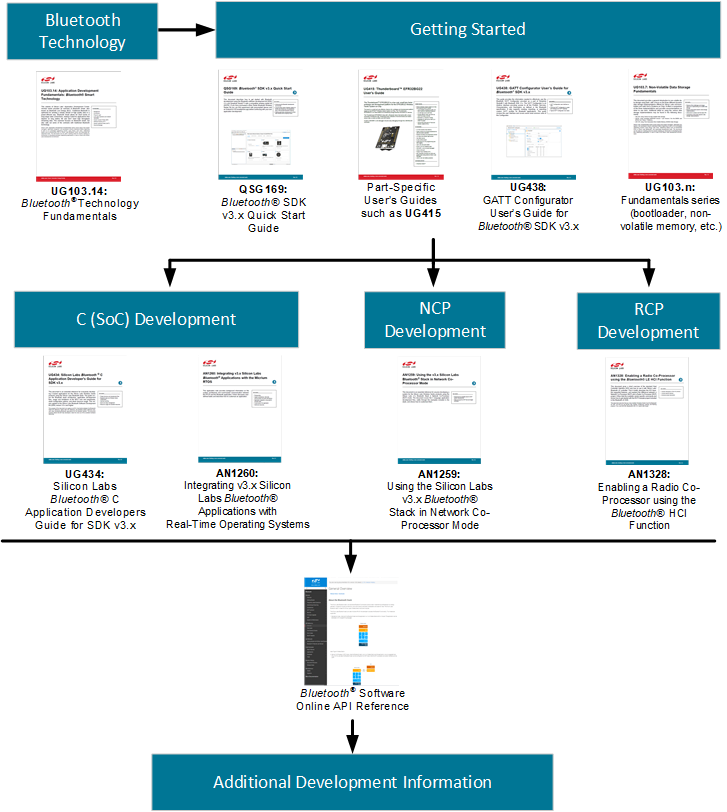General Overview#
Silicon Labs Bluetooth LE Documentation | Release Notes | Downloads
About the Bluetooth Stack#
The v3.x Silicon Labs Bluetooth stack is an advanced Bluetooth 5-compliant protocol stack implementing the Bluetooth low energy standard. It supports multiple connections, concurrent central, peripheral, broadcaster, and observer roles. The v3.x Silicon Labs Bluetooth stack is meant for Silicon Labs EFR32 SoCs and modules.
The Silicon Labs Bluetooth stack provides multiple APIs for the developer to access the Bluetooth functionality. Three modes are supported:
Standalone mode, where both the Bluetooth stack and the application run in an EFR32SoC or module. The application can be developed with C programming language.


Network Co-Processor (NCP) mode, where the Bluetooth stack runs in an EFR32 and the application runs on a separate host MCU. For this use case, the Bluetooth stack can be configured into NCP mode where the API is exposed over a serial inter- face such as UART.


Radio Co-Processor (RCP) mode, where only the Link Layer of the Bluetooth stack runs on the EFR32, and the Host Layer of the stack, as well as the application, runs on a separate host MCU or PC. In this use case, the Host Layer is developed by a third party, since Silicon Labs’ Bluetooth stack is only built for EFR32 SoCs / modules. The Link Layer and the host layer communicate via HCI (Host-Controller Interface), which is a standard interface between the two layers. The HCI can be accessed via UART following the Bluetooth SIG's UART (H4) transport protocol.
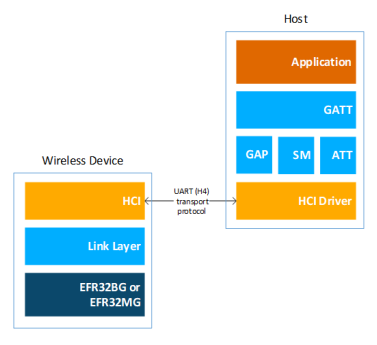

Bluetooth Stack Features#
The features of the Silicon Labs Bluetooth stack are listed in the following table.
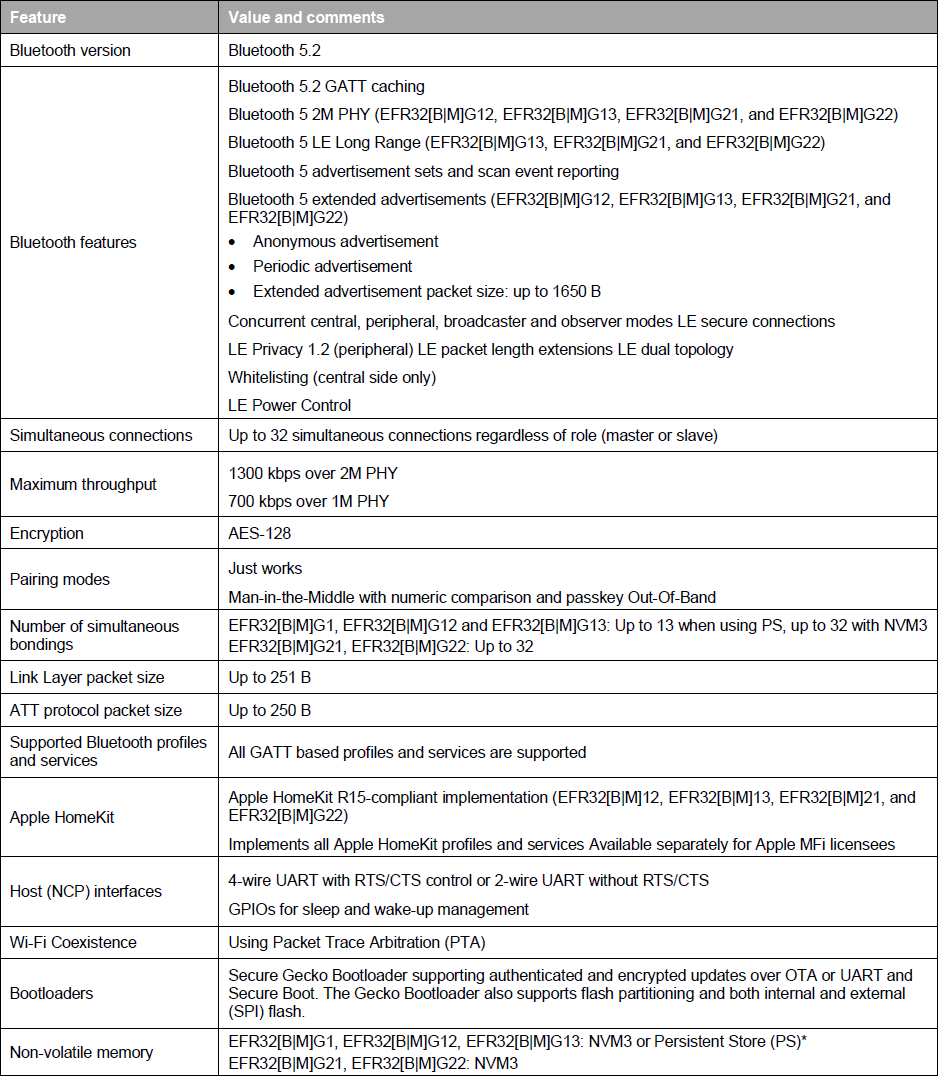

Bluetooth Qualification#
All products deploying Bluetooth technology must go through the Bluetooth SIG's Qualification Process. Online resources will help you learn more about the Bluetooth Qualification, process, and tutorials on the Launch Studio, which is the online tool used to complete the Bluetooth Qualification Process. For assistance to qualify your device, consider reaching out to your nearest Bluetooth Qualification Consultant.
When qualifying your end-product based on Silicon Labs’ Bluetooth stack, integrate the pre-qualified components. To learn more and see the list of pre-qualified components, see QSG169: Bluetooth® SDK v3.x Quick-Start Guide.
The Bluetooth Stack APIs#
This section briefly describes the different software APIs.
The Bluetooth API#
The Bluetooth API provided by the Silicon Labs Bluetooth stack is the primary API to communicate with the stack. It provides access to all the Bluetooth functionality implemented by the Bluetooth stack, such as the Generic Access Profile (GAP), connection manager, the security manager (SM), GATT client and server.
In addition to the Bluetooth features, the Bluetooth API also provides access to a few other functions such as the Direct Test Mode (DTM) API for RF testing purposes, the Persistent Store (PS) API for reading and writing keys to and from the devices flash memory, the DFU (Device Firmware Update) API for field firmware updates, and the System API for various system level functions.
The BGAPI Serial Protocol and the Bluetooth Host API#
When configured in NCP (network co-processor) mode, the Bluetooth stack can be controlled using the BGAPI serial protocol. This allows the Bluetooth stack to be controlled over a serial interface such as UART from a separate host, such as EFM32 microcontroller. The BGAPI serial protocol provides exactly the same Bluetooth APIs over UART as the BGAPI API when used in a standalone mode.
The BGAPI serial protocol is a lightweight, binary protocol that carries the BGAPI commands from the host to the Bluetooth stack, and carries responses and events from the Bluetooth stack back to the host.
The Bluetooth SDK delivers a ready-made BGAPI serial protocol parser implementation both for the NCP target (EFR) and for the NCP host. It implements the serial protocol parser for all APIs provided by the Bluetooth stack. The host code developed on top of host API can be written to be identical to the code for the EFR, which allows easy porting of the application code from the EFR to a separate host or vice versa.
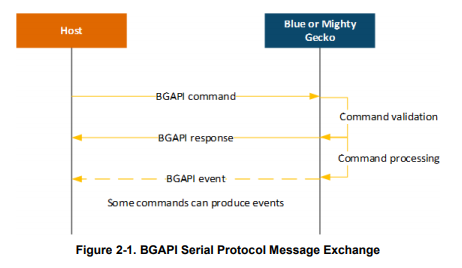

The BGAPI serial protocol packet structure is described below. For more information, see the BGAPI Headers.


The Bluetooth Profile Toolkit GATT Builder#
The Bluetooth Profile Toolkit is an XML-based API and description language used to describe the GATT-based service and characteristic easily without writing code. The XML files can be easily written by hand based on the information contained in UG118: Blue Gecko Bluetooth® Profile Toolkit Developer Guide. Use the Profile Toolkit GATT Builder if you are developing outside of Simplicity Studio.
Within Simplicity Studio, the GATT Configurator allows building the GATT in a visual way without hand editing the XML file. See UG438: GATT Configurator User’s Guide for Bluetooth SDK v3.x for details. Open the GATT Configurator in Simplicity Studio through the Project Configurator, Software Components tab, under Advanced Configurators. Click Open and the GATT Configurator tool opens the file gatt_configuration.btconf in a new tab.


gatt_configuration.btconf provides the trunk of the GATT database. It is located inside the config > btconfig directory of your project. You can add additional XML files in the same directory and extend the GATT database. The contents of the additional XML files will appear as Contributed Items in the GATT Configurator UI. For examples, see the ota-dfu.xml file provided with most sample applications.
The GATT database developed with the Profile Toolkit is converted to a .c file and a .h file and included in the application project as a pre-build step when the firmware is compiled. Then, the GATT can be accessed with the Bluetooth stack GATT APIs or by a remote Bluetooth device.


CMSIS and EMLIB#
The Cortex Microcontroller Software Interface Standard (CMSIS) is a common coding standard for all ARM Cortex devices. The CMSIS library provided by Silicon Labs contains header files, defines (for peripherals, registers and bitfields), and startup files for all devices. In addition, CMSIS includes functions that are common to all Cortex devices, such as interrupt handling, intrinsic functions, and so on. Although you can write to registers using hard-coded address and data values, it is recommended to use the defines to ensure portability and readability of the code.
To simplify programming Wireless Geckos, Silicon Labs develops and maintains a complete C function library called EMLIB that provides efficient, clear, and robust access to and control of all peripherals and core functions in the device. This library is within the em_xxx.c (for example, em_dac.c) and em_xxx.h files in the SDK. The EMLIB documentation is available in the Gecko Platform documentation.
About the Bluetooth SDK#
The Bluetooth SDK is a full software development kit that enables you to develop applications on top of the Bluetooth stack using C programming language. The SDK also supports making standalone applications, where the Bluetooth stack and the application both run in the Wireless Gecko, or the network co-processor (NCP) architecture, where the application runs on an external host and the Bluetooth stack runs in the Wireless Gecko. SDK contents and folder structure are described in QSG169: Bluetooth® SDK v3.x Quick-Start Guide.
About Demos and Examples#
Starting application development from scratch can be difficult. For that reason, the Bluetooth SDK comes with a number of built-in demos and examples covering the most frequent use cases, as shown in the following figure. Demos are pre-built application images that you can run immediately. Software examples can be modified before building the application image. Demos with the same name as software examples are built from their respective example.
Note: The demos and examples you see are determined by the part selected. If you are using a custom solution with more than one part, click on the part you are working with to see only the items applicable to that part.
Demos and Software Example are in the Example Projects & Demos tab in the launcher view of Simplicity Studio.
To download and run a demo on your device, click RUN on the right demo you want to run on your target.
To import software example code into your workspace as a new project using default project configurations, click CREATE on the name of the desired example project and a New Project Wizard window will open. Click FINISH and your project will open in Simplicity IDE mode where you can customize it.
If an example project closely matches your needs, extend the code with your application code and rewrite the custom sections. Otherwise, start with the SoC-Empty application. Note that the SoC-Empty application is not blank, but rather provides a minimal project that only starts advertising.
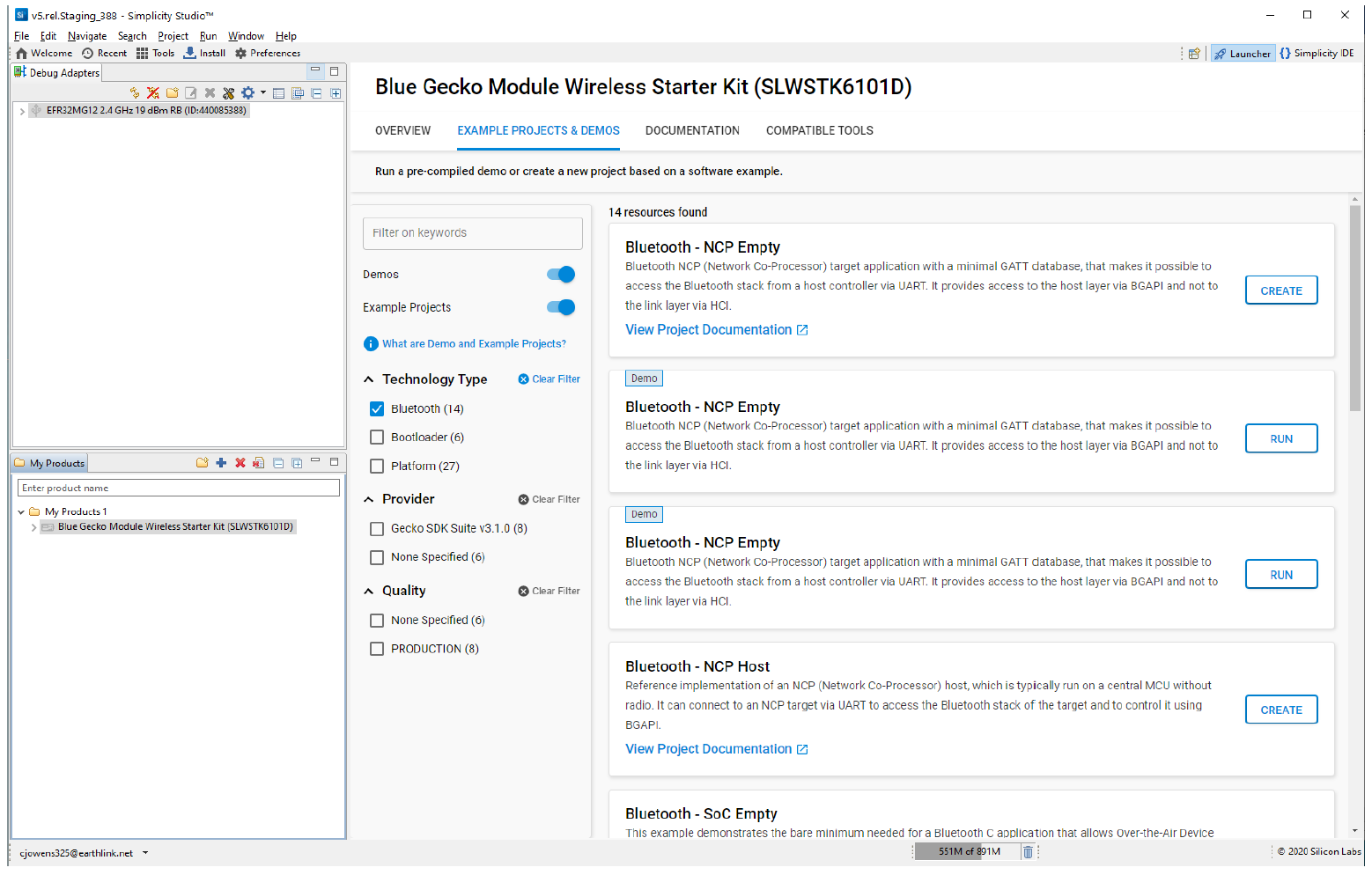

Demo/Example Descriptions#
The following examples are provided. Examples with (*) in their names have a matching pre-built demo.
Silicon Labs Gecko Bootloader examples (see UG266: Silicon Labs Gecko Bootloader User Guide and AN1086: Using the Gecko Bootloader with Silicon Labs Bluetooth Applications)
Bluetooth Examples
Bluetooth – RCP: Radio Co-Processor (RCP) target application. Runs the Bluetooth Controller (i.e. the Link Layer only) and provides access to it using the standard HCI (Host-Controller Interface) over a UART connection.
Bluetooth – NCP(*): Network Co-Processor (NCP) target application. Runs the full Bluetooth stack and provides access to it by exposing the Bluetooth API (BGAPI) via UART connection. NCP mode makes it possible to run your application on a host controller or PC. This example does not have a GATT database, but makes it possible to build one from the application using the Dynamic GATT API.
Bluetooth – NCP Empty(*): Network Co-Processor (NCP) target application. Runs the full Bluetooth stack and provides access to it by exposing the Bluetooth API (BGAPI) via UART connection. NCP mode makes it possible to run your application on a host controller or PC. This example contains a minimal GATT database, and cannot be used with host applications that use the Dynamic GATT API.
Bluetooth – NCP Host: Reference implementation of an NCP (Network Co-Processor) host, which typically runs on a central MCU without radio. It can connect to an NCP target via UART to access the Bluetooth stack of the target and to control it using BGAPI. This example uses the Dynamic GATT feature.
Bluetooth – NCP AoA Locator(*): Network Co-Processor (NCP) target application extended with CTE Receiver support. It enables Angle of Arrival (AoA) calculation. Use this application with Direction Finding host examples.
Bluetooth – SoC AoA Asset Tag(*): Demonstrates a CTE (Constant Tone Extension) transmitter that can be used as an asset tag in a Direction Finding setup estimating Angle of Arrival (AoA).
Bluetooth – SoC Blinky(*): The classic blinky example using Bluetooth communication. From the EFR Connect mobile app, the LED controller button toggles LED0 on the board. In addition, pressing or releasing PB0 on the mainboard notifies the app. This is a demonstration of a simple two-way data exchange over GATT.
Bluetooth – SoC DTM: This example implements the direct test mode (DTM) application for radio testing. DTM commands can be called via UART. See AN1267: Radio Frequency Physical Layer Evaluation in Bluetooth® SDK v3.x for more information.
Bluetooth – SoC Empty: A minimal project structure that serves as a starting point for custom Bluetooth applications. It contains a minimal GATT database that can be expanded to fit your application requirements. The application starts advertising after boot and restarts advertising after a connection is closed. It also supports Over-the-Air Device Firmware Upgrade (OTA DFU)
Bluetooth – SoC Interoperability Test (*): A test procedure containing several test cases for Bluetooth Low Energy communication. This demo is meant to be used with the EFR Connect mobile app, through the "Interoperability Test" tile on the Develop view of the app.
Bluetooth – SoC Thermometer(*): Implements a GATT Server with the Health Thermometer Profile, which enables a Client device to connect and get temperature data. Temperature is read from the Si7021 digital relative humidity and temperature sensor of the WSTK or of the Thunderboard.
Bluetooth – SoC Thermometer Client: Implements a GATT Client that discovers and connects with up to four Bluetooth LE devices advertising themselves as Thermometer Servers. It displays the discovery process and the temperature values received via UART.
Note: Some radio boards will exhibit random pixels in the display when this example is running because they have a shared pin for sensor- and display-enabled signals.
Bluetooth – SoC Thermometer FreeRTOS: Demonstrates the integration of FreeRTOS into Bluetooth applications. RTOS is added to the Bluetooth - SoC Thermometer sample app.
Bluetooth – SoC Thermometer Micrium OS: Demonstrates the integration of Micrium RTOS into Bluetooth applications. RTOS is added to the Bluetooth - SoC Thermometer sample app.
Bluetooth – SoC Throughput(*): Tests the throughput capabilities of the device and can be used to measure throughput between two EFR32 devices, as well as between a device and a smartphone using the EFR Connect mobile app, through the Throughput demo tile.
Bluetooth – SoC Voice(*): Voice over Bluetooth Low Energy sample application. It is supported by Thunderboard Sense 2 and Thunderboard EFR32BG22 boards and demonstrates how to send voice data over GATT, which is acquired from the on-board microphones.
Bluetooth – SoC iBeacon(*): An iBeacon device implementation that sends non-connectable advertisements in iBeacon format. The iBeacon Service gives Bluetooth accessories a simple and convenient way to send iBeacons to smartphones. This example can be tested together with the EFR Connect mobile app.
Bluetooth – SoC Thunderboard Sense 2( * ), and Thunderboard EFR32BG22( * ): Demonstrate the features of the Thunderboard Kit. These can be tested with the Thunderboard mobile app.
Dynamic Multiprotocol Examples (see AN1134: Dynamic Multiprotocol Development with Bluetooth and Proprietary Protocols on RAIL for more information)
Bluetooth – SoC Empty RAIL DMP FreeRTOS: A minimal project structure, used as a starting point for custom Bluetooth + Proprietary DMP (Dynamic Multiprotocol) applications. It runs on top of FreeRTOS and multiprotocol RAIL.
Bluetooth – SoC Empty RAIL DMP Micrium OS: A minimal project structure, used as a starting point for custom Bluetooth + Proprietary DMP (Dynamic Multiprotocol) applications. It runs on top of Micrium OS and multiprotocol RAIL.
Bluetooth – SoC Empty Standard DMP FreeRTOS: A minimal project structure, used as a starting point for custom Bluetooth + Standard DMP (Dynamic Multiprotocol) applications. It runs on top of FreeRTOS and multiprotocol RAIL utilizing IEE802.15.4 standard protocol.
Bluetooth – SoC Empty Standard DMP Micrium OS: A minimal project structure, used as a starting point for custom Bluetooth + Standard DMP (Dynamic Multiprotocol) applications. It runs on top of Micrium OS and multiprotocol RAIL, utilizing IEE802.15.4 standard protocol.
Bluetooth – SoC Light RAIL DMP FreeRTOS(*): A Dynamic Multiprotocol reference application demonstrating a light bulb that can be switched both via Bluetooth and via a Proprietary protocol. To switch it via Bluetooth use the Wireless Gecko smartphone app. To switch it via Proprietary protocol use the Flex (RAIL) - Switch sample app.
Bluetooth – SoC Light RAIL DMP Micrium OS: A Dynamic Multiprotocol reference application demonstrating a light bulb that can be switched both via Bluetooth and via a Proprietary protocol. To switch it via Bluetooth use the Wireless Gecko smartphone app. To switch it via Proprietary protocol use the Flex (RAIL) - Switch sample app.
Bluetooth – SoC Light Standard DMP FreeRTOS(*): A Dynamic Multiprotocol reference application demonstrating a light bulb that can be switched both via Bluetooth and via a standard protocol. To switch it via Bluetooth use the Wireless Gecko smartphone app. To switch it via standard protocol use the "Flex (RAIL) - Switch Standards" sample app.
Bluetooth – SoC Light Standard DMP Micrium OS(*): A Dynamic Multiprotocol reference application demonstrating a light bulb that can be switched both via Bluetooth and via a standard protocol. To switch it via Bluetooth use the Wireless Gecko smartphone app. To switch it via standard protocol use the "Flex (RAIL) - Switch Standards" sample app.
NCP Host Examples (located in C:\SiliconLabs\SimplicityStudio\v5\developer\sdks\gecko_sdk_suite<version>\app\bluetooth\examples_host)
empty: Minimal host-side project structure, used as a starting point for NCP host applications. Use it with the Bluetooth – NCP target application flashed to the radio board.
ota-dfu: Demonstrates how to perform an OTA DFU on a Silicon Labs Bluetooth Device. It requires a WSTK with a radio board flashed with NCP firmware to be used as the GATT client that performs the OTA.
uart-dfu: Demonstrates how to perform a UART DFU on a Silicon Labs Bluetooth Device running NCP firmware
voice: On a WSTK programmed with NCP firmware, it to connects to the Bluetooth – SoC Voice example, sets the correct configuration on it, receives audio via Bluetooth, and stores audio data into a file.
aoa_locator: A locator host sample app that works together with a Bluetooth – NCP AoA Locator target app. It receives IQ samples from the target and estimates the Angle of Arrival (AoA). For more information see AN1296: Application Development with Silicon Labs’ RTL Library.
aoa_multilocator: Connects to multiple aoa_locator sample apps (via MQTT) and estimates a position from Angles of Arrival (AoA). For more information, see AN1296: Application Development with Silicon Labs’ RTL Library.
aoa_multilocator_gui: Connects to the aoa_multilocator sample app (via MQTT), reads out the position estimations and displays the tags and locators on a 3D GUI. This sample app is python based. For more information, see AN1296: Application Development with Silicon Labs’ RTL Library.
aoa_compass: Demo application with GUI showcasing the angle estimation capabilities of the RTL library. This is now replaced with the AoA Analyzer tool as described in QSG175: Silicon Labs Direction Finding Solution Quick-Start Guide.
throughput: Tests the throughput capabilities of the device in NCP mode and can be used to measure throughput between two devices as well as between a device and a smartphone
Python-Based NCP Host Examples
Python-based NCP host examples can be accesssed at https://github.com/SiliconLabs/pybgapi-examples. These examples are meant to be used with PyBGAPI (https://pypi.org/project/pybgapi/).
Silicon Labs Bluetooth LE Documentation#
A graphic representation of the documentation set is at the end of this list.
Getting Started#
Getting Started with Simplicity Studio 5 and the Gecko SDK - Describes downloading development tools and the Gecko SDK, which includes the Silicon Labs Bluetooth SDK. Introduces the Simplicity Studio 5 interface.
UG103.14: Bluetooth LE Fundamentals - Offers an overview for those new to the Bluetooth low energy technology.
QSG169: Bluetooth SDK v3.x Quick Start Guide - Describes using the Simplicity Studio 5 IDE and tools for application development with Bluetooth SDK v3.x.
AN1255: Transitioning from the v2.x to the v3.x Bluetooth SDK - Describes the differences between using Bluetooth SDK v2.x in Simplicity Studio 4 and usingBluetooth SDK v3.x in Simplicity Studio 5. Outlines the steps needed to migrate a v2.x project to v3.x.
Developing with Bluetooth LE#
UG434: Silicon Labs Bluetooth C Application Developer's Guide for SDK v3.x - Covers the Bluetooth stack v3.x architecture, application development flow, using the MCU core and peripherals, stack configuration options, and stack resource usage.
UG438: GATT Configurator User's Guide - Describes how to use the Simplicity Studio 5 GATT Configurator, an intuitive interface providing access to all the Profiles, Services, Characteristics, and Descriptors as defined in the Bluetooth specification.
UG118: Blue Gecko Bluetooth Profile Toolkit Developer's Guide - Reviews using this XML-based mark-up language to describe the Bluetooth GATT database,configure access and security properties, and include the GATT database as part of the firmware.
AN1259: Using the v3.x Silicon Labs Bluetooth Stack in Network Co-Processor Mode - Describes how to configure the NCP target and how to program the NCP host when using the Bluetooth Stack in Network Co-Processor mode
AN1328: Enabling a Radio Co-Processor using the Bluetooth Controller and HCI Functions - Gives a short overview of the standard Host Controller Interface (HCI) and how to use it with a Silicon Labs Bluetooth LE controller.
AN1260: Integrating v3.x Silicon Labs Bluetooth Applications with Real-Time Operating Systems - Describes how to integrate a v3.x Silicon Labs Bluetooth application with an RTOS, and demonstrate how a time- and event-driven application can be run in parallel with the Bluetooth stack.
AN1362: Amazon FreeRTOS Architecture and Sample Applications - Summarizes Amazon FreeRTOS components and sample applications, and explains how to use the examples to communicate with the Amazon Web Services (AWS) cloud with a smart phone app.
AN1366: Bluetooth LE Use Case-Based Low Power Optimization - Describes how to exploit the different features of Bluetooth technology to achieve the minimum possible energy consumption for a given use case.
UG162: Simplicity Commander Reference Guide - Describes how and when to use Simplicity Commander's Command-Line Interface.
Direction Finding#
UG103.18: Bluetooth Direction Finding Fundamentals - Explains the basics of Bluetooth Angle of Arrival (AoA) and Angle of Departure (AoD) direction finding technologies and provides the theory behind estimating angle of arrival.
QSG175: Silicon Labs' Direction Finding Solution Quick-Start Guide - Describes the software components provided by Silicon Labs to support Direction Finding (DF) and provides instructions on how to start developing your own application.
AN1296: Application Development with Silicon Labs' RTL Library - Describes the sample applications provided to demonstrate the directing finding capabilities of Bluetooth 5.1. Angle of Arrival (AoA) estimation is demonstrated with the use of Silicon Labs' Real Time Locating (RTL) library.These techniques are applicable to the EFR32MGx and EFR32BGx series.
AN1297: Custom Direction-Finding Solutions using Silicon Labs' Bluetooth Stack - Bluetooth 5.1 makes it possible to send Constant Tone Extensions (CTEs) in Bluetooth packets on which phase measurements can be done. This guide is for those implementing custom applications that take advantage of phase measurement and antenna switching capabilites.
UG514: Using the Bluetooth Direction Finding Tool Suite - The Bluetooth Direction Finding Tool Suite is meant to ease development with the Silicon Labs' RTL library. It provides multiple tools to configure the system, and also helps the development with analyzer tools that calculate many output parameters from the observed IQ samples.
Multiprotocol#
UG103.16: Multiprotocol Fundamentals - Describes the four multiprotocol modes, discusses considerations when selecting protocols for multiprotocol implementations, and reviews the Radio Scheduler, a required component of a dynamic multiprotocol solution.
UG305: Dynamic Multiprotocol User's Guide - Describes how to implement a dynamic multiprotocol solution.
AN1269: Dynamic Multiprotocol Development with Bluetooth and Proprietary Protocols on RAIL in GSDK v3.x - Provides details on how to develop a dynamic multiprotocol application running Bluetooth and aproprietary protocol on RAIL in GSDK v3.x.
AN1333: Running Zigbee, OpenThread, and Bluetooth Concurrently on a Linux Host with a Multiprotocol RCP - Describes how to run any combination of Zigbee EmberZNet, OpenThread, and Bluetooth networking stacks on a Linux host processor, interfacing with a single EFR32 Radio Coprocessor (RCP) with multiprotocol and multi-PAN support.
Coexistence#
UG103.17: Wi-Fi Coexistence Fundamentals - Introduces methods to improve the coexistence of 2.4 GHz IEEE 802.11b/g/n Wi-Fi and other 2.4 GHz radios such as Bluetooth, Bluetooth Mesh, Bluetooth Low Energy, and IEEE 802.15.4-based radios such as Zigbee and OpenThread.
AN1128: Bluetooth Coexistence with Wi-Fi - Describes the Wi-Fi impact on Bluetooth and methods to improve Bluetooth coexistence with Wi-Fi.Explains design considerations to improve coexistence without direct interaction between Bluetooth and Wi-Fi radios.These techniques are applicable to the EFR32MGx and EFR32BGx series. Discusses the Silicon Labs Packet Traffic Arbitration (PTA) support to coordinate 2.4GHz RF traffic for co-located Bluetooth and Wi-Fi radios.
Security#
UG103.05: IoT Endpoint Security Fundamentals - Introduces the security concepts that must be considered when implementing an Internet of Things (IoT) system. Using the ioXt Alliance's eight security principles as a structure, it clearly delineates the solutions Silicon Labs provides to support endpoint security and what you must do outside of the Silicon Labs framework.
AN1302: Bluetooth Low Energy Application Security Design Considerations in SDK v3.x - Provides details on designing Bluetooth Low Energy applications with security and privacy in mind.
AN1190: Series 2 Secure Debug - Describes how to lock and unlock the debug access of EFR32 Gecko Series 2 devices. Many aspects of the debug access, including the secure debug unlock are described. The Debug Challenge Interface (DCI) and Secure Engine (SE) Mailbox Interface for locking and unlocking debug access are also included.
AN1222: Production Programming of Series 2 Devices - Provides details on programming, provisioning, and configuring Series 2 devices in production environments. Covers Secure Engine Subsystem of Series 2 devices, which runs easily upgradeable Secure Engine (SE) or Virtual Secure Engine (VSE) firmware.
AN1247: Anti-Tamper Protection Configuration and Use - Shows how to program, provision, and configure the anti-tamper module on EFR32 Series 2 devices with Secure Vault.
AN1268: Authenticating Silicon Labs Devices using Device Certificates - How to authenticate an EFR32 Series 2 device with Secure Vault, using secure device certificates and signatures.
AN1271: Secure Key Storage - Explains how to securely "wrap" keys in EFR32 Series 2 devices with Secure Vault, so they can be stored in non-volatile storage.
AN1303: Programming Series 2 Devices Using the Debug Challenge Interface (DCI) and Serial Wire Debug (SWD) - Describes how to provision and configure Series 2 devices through the DCI and SWD.
AN1311: Integrating Crypto Functionality Using PSA Crypto Compared to Mbed TLS - Describes how to integrate crypto functionality into applications using PSA Crypto compared to Mbed TLS.
Bootloading#
UG103.06: Bootloader Fundamentals - Introduces bootloading for Silicon Labs networking devices. Discusses the Gecko Bootloader as well as legacy Ember and Bluetooth bootloaders, and describes the file formats used by each.
UG489: Silicon Labs Gecko Bootloader User's Guide for GSDK 4.0 and Higher - Describes the high-level implementation of the Silicon Labs Gecko Bootloader for EFR32 SoCs and NCPs, and provides information on how to get started using the Gecko Bootloader with Silicon Labs wireless protocol stacks in GSDK 4.0 and higher.
AN1086: Using the Gecko Bootloader with Silicon Labs Bluetooth Applications - Includes detailed information on using the Gecko Bootloader with Silicon Labs Bluetooth applications. It supplements the general Gecko Bootloader implementation information provided in UG489: Silicon Labs Gecko Bootloader User's Guide for GSDK 4.0 and Higher.
AN1326: Transitioning to the Updated Gecko Bootloader in GSDK 4.0 and Higher - Gecko Bootloader v2.x, introduced in GSDK 4.0, contains a number of changes compared to Gecko Bootloader v1.x. This document describes the differences between the versions, including how to configure the new Gecko Bootloader in Simplicity Studio 5.
AN1218: Series 2 Secure Boot with RTSL - Contains detailed information on configuring and using the Secure Boot with hardware Root of Trust and Secure Loader on Series 2 devices, including how to provision the signing key. This is a companion document to UG489: Silicon Labs Gecko Bootloader User's Guide for GSDK 4.0 and Higher.
Non-Volatile Data Storage#
UG103.07: Non-Volatile Data Storage Fundamentals - Introduces non-volatile data storage using flash and the three different storage implementations offered for Silicon Labs microcontrollers and SoCs: Simulated EEPROM, PS Store, and NVM3.
AN1135: Using Third Generation Non-Volatile Memory (NVM3) Data Storage - Explains how NVM3 can be used as non-volatile data storage in various protocol implementations.
Testing#
AN1246: EFR32BG SoC Bluetooth Smart Device Power Consumption Measurements - Describes how to measure the power consumption of EFR32BG devices running the Bluetooth i-Beacon example.For general instructions, see AN969: Measuring Power Consumption in Wireless Gecko Devices.
AN1267: Radio Frequency Physical Layer Evaluation in Bluetooth SDK v3.x - Reviews performing radio frequency physical layer evaluation with EFR32BG SoCs and BGM modules using the Direct Test Mode protocol in Bluetooth SDK v3.x.
AN1317: Using Network Analyzer with Bluetooth Low Energy and Mesh - Describes using Simplicity Studio 5's Network Analyzer to debug Bluetooth Mesh and Low Energy applications. It can be read jointly with AN958: Debugging and Programming Interfaces for Customer Designs for more information on using Packet Trace Interface with custom hardware.
AN1309: Bluetooth Low Energy Interoperability Testing Report - Includes the results of the interoperability testing of Silicon Labs' ICs and Bluetooth Low Energy stack with Android and iOS smart phones.
Documentation Flow#
